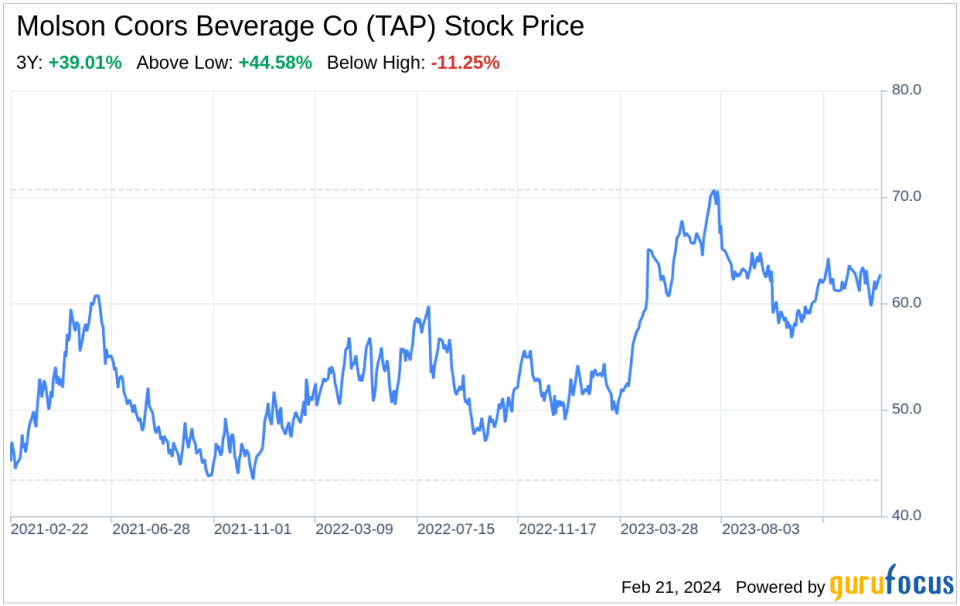Decoding Molson Coors Beverage Co (TAP): A Strategic SWOT Insight
Robust brand portfolio with core power brands driving market presence.
Strategic expansion beyond beer into flavored beverages and spirits.
Challenges include intense competition and evolving consumer preferences.
Opportunities for growth in premium product segments and emerging markets.
On February 20, 2024, Molson Coors Beverage Co (NYSE:TAP) filed its annual 10-K report, providing a comprehensive overview of its financial health and strategic direction. The company, known for its iconic beer brands such as Miller, Coors, and Blue Moon, continues to assert its position as a leading brewer while expanding its portfolio to include hard seltzers and spirits. Despite facing a highly competitive market, Molson Coors has maintained a strong balance sheet, with a diverse product range catering to various consumer tastes and price points. The following SWOT analysis delves into the strengths, weaknesses, opportunities, and threats as disclosed in the recent filing, offering investors a nuanced perspective on the company's prospects.

Strengths
Brand Portfolio and Market Presence: Molson Coors Beverage Co (NYSE:TAP) boasts a powerful array of core power brands, including Coors Light, Miller Lite, and Blue Moon, which have cemented the company's market presence. These brands have not only demonstrated enduring consumer appeal but have also allowed the company to command significant shelf space and customer loyalty. The company's strategic partnerships and licensing agreements with other major players like Heineken and Coca-Cola have further expanded its reach, enabling it to leverage a broad distribution network and capitalize on established brand equity.
Financial Resilience and Diversification: The company's financial statements reflect a robust balance sheet with healthy cash flows, indicative of its financial resilience. Molson Coors has diversified its revenue streams by venturing into the flavored malt beverage segment and the spirits category, with acquisitions such as the 75% equity interest in Blue Run, a high-end whiskey business. This diversification strategy not only mitigates risks associated with market fluctuations in the beer segment but also positions the company to tap into the growing demand for premium and craft beverages.
Weaknesses
Debt and Operating Restrictions: Despite a strong balance sheet, Molson Coors carries a notable level of debt, which could impose operating covenants and restrictions that limit strategic flexibility. The company's credit rating is subject to the performance of the business and market conditions, and any deterioration could increase borrowing costs or limit access to capital markets. This financial leverage, while manageable, necessitates prudent financial management to ensure long-term sustainability.
Dependence on Core Brands: The company's reliance on a small number of core brands for a significant portion of its sales volume presents a vulnerability. Should consumer preferences shift away from these flagship products, Molson Coors could face substantial revenue impacts. This dependence underscores the need for continuous innovation and marketing efforts to maintain the relevance and competitiveness of these key brands.
Opportunities
Expansion into New Segments and Markets: The evolving consumer trends toward premium and above-premium products, including hard seltzers and spirits, present significant growth opportunities for Molson Coors. The company's recent foray into these segments aligns with market dynamics, and further investment in innovation could capture additional market share. Moreover, emerging and developing markets offer untapped potential for expansion, where the company can leverage its extensive portfolio and distribution capabilities.
Adaptation to Changing Consumer Preferences: Molson Coors has the opportunity to lead the industry in responding to the shift in consumer purchasing behavior, particularly within the premium segment. By focusing on consumer insights and adapting its product offerings accordingly, the company can strengthen its position in the market. Strategic marketing and promotional activities can enhance brand visibility and appeal to a broader demographic, capitalizing on the growing interest in craft and specialty beverages.
Threats
Intense Competition and Market Consolidation: The beer industry is characterized by intense competition from both large global brewers and smaller craft producers. Molson Coors faces the challenge of differentiating its products in a crowded marketplace while contending with the aggressive marketing and pricing strategies of competitors. Market consolidation could also lead to stronger competitors and shifts in distributor networks, potentially impacting the company's market share and profitability.
Regulatory and Economic Risks: Molson Coors operates in a highly regulated industry, with varying distribution systems and trade regulations across different regions. Changes in tax, environmental, and trade policies could impose additional costs or disrupt operations. Economic trends, such as fluctuations in foreign exchange rates and consumer spending patterns, also pose risks that could affect the company's financial performance.
In conclusion, Molson Coors Beverage Co (NYSE:TAP) exhibits a strong market presence backed by a diverse and iconic brand portfolio. The company's strategic expansion into new beverage segments and markets positions it well to capitalize on evolving consumer trends. However, challenges such as debt management, reliance on core brands, intense competition, and regulatory complexities must be navigated carefully. By leveraging its strengths and addressing its weaknesses, Molson Coors can seize opportunities for growth while mitigating potential threats in the dynamic beverage industry.
This article, generated by GuruFocus, is designed to provide general insights and is not tailored financial advice. Our commentary is rooted in historical data and analyst projections, utilizing an impartial methodology, and is not intended to serve as specific investment guidance. It does not formulate a recommendation to purchase or divest any stock and does not consider individual investment objectives or financial circumstances. Our objective is to deliver long-term, fundamental data-driven analysis. Be aware that our analysis might not incorporate the most recent, price-sensitive company announcements or qualitative information. GuruFocus holds no position in the stocks mentioned herein.
This article first appeared on GuruFocus.
